Number of constructions drop by 2.8 percent in 2019
The total number of constructions from approved building permits issued by the Local Building Officials (LBOs) for the year 2019 reached 19,826. This number is lower by 2.8 percent from the 20,397 constructions recorded in 2018. (Table A)
By type of construction, residential had the highest number at 15,350 or 77.4 percent of the total number of constructions. The number of residential constructions posted an 8.8 percent decrease from the 16,831 residential constructions reported in 2018.
Majority or 91.6 percent of the total residential construction were single-type houses. Construction of residential condominiums posted the least share of 0.1 percent to the total residential construction. (Figure 1)
The total number of non-residential constructions reached 3,031 which accounted for 15.3 percent of the total construction. This was 20.2 percent higher than the s2,552 non-residential constructions recorded in 2018. Among the types of non-residential construction, commercial building contributed the highest share of 66.9 percent. (Tables A and A.1, and Figure 1)
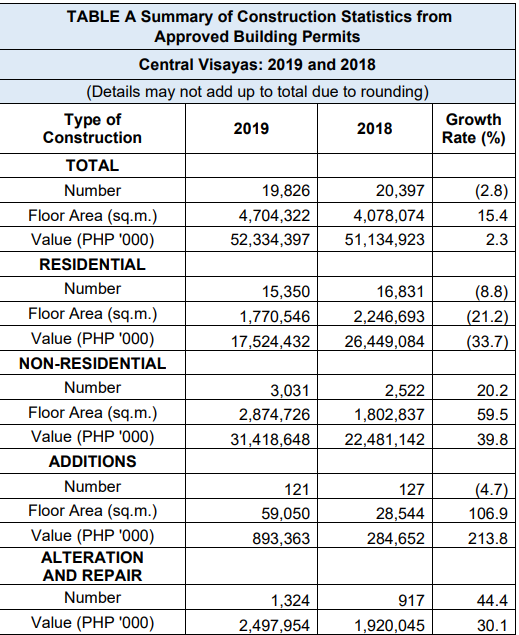
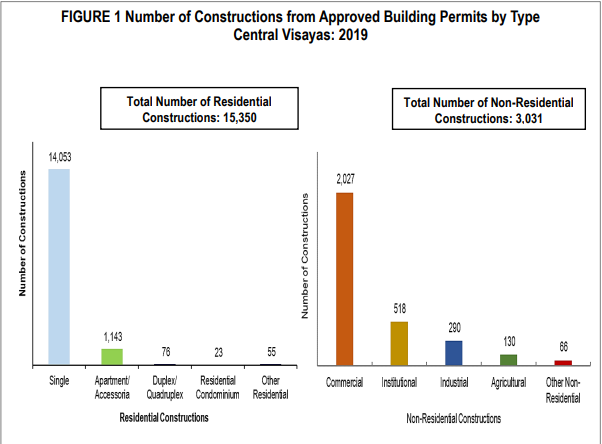
The number of constructions for addition to existing structures at 121 declined by 4.7 percent than the previous year’s count of 127. On the other hand, the combined construction for alteration and repair of existing structure at 1,324 was higher by 44.4 percent, from the 917 projects recorded in 2018.
Among provinces in terms of number of constructions, Cebu had 7,117 constructions (35.9%), Bohol had 6,816 constructions (34.4%), Negros Oriental had 5,552 constructions (28.0%) and Siquijor had 341 constructions (1.7) percent.
Total value of construction increases by 2.3 percent
In 2019, the total value of construction amounted to PHP52.3 billion. This value increased by 2.3 percent from the PHP51.1 billion value of construction in 2018. (Table A)
Residential building construction, valued at PHP17.5 billion, accounted for 33.7 percent of the total value. This shows a decrease from the PHP26.4 billion construction value posted in 2018. (Tables A and A.1, and Figure 3)
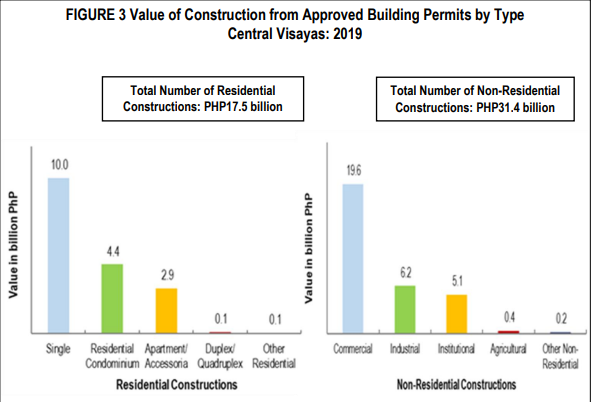
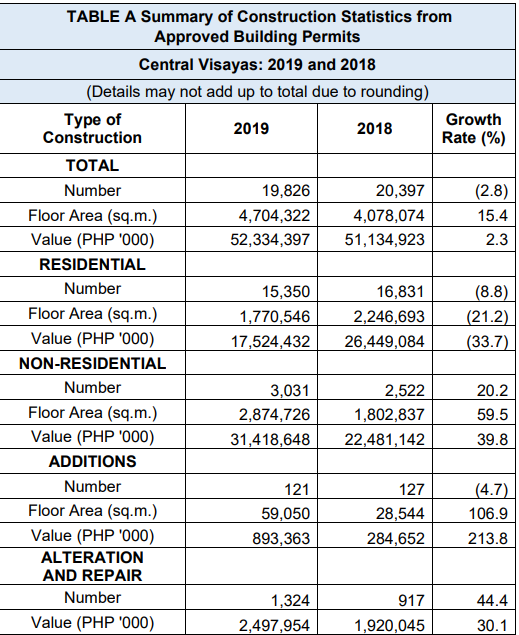
Construction value of non-residential buildings amounted to PHP31.4 billion (60.0%), a 39.8 percent increase from the PHP22.5 billion value of construction of the previous year.
Moreover, construction value of addition to existing structures, which amounted to PHP0.9 billion or 1.7 percent of the total, increased by 213.8 percent, from the PhP0.3 billion in 2018. Similarly, combined construction of alteration and repair of existing structures at PHP2.5 billion (4.8%) increased by 30.1 percent, from the PHP1.9 billion construction value recorded in the previous year. (Table A.1)
Of the PHP52.3 billion value of construction in Central Visayas, the following contributions of the provinces were: (Figure 4)
Cebu, PHP39.9 billion (76.2%)
Bohol, PHP8.1 billion (15.4%)
Negros Oriental, PHP3.9 billion (7.5%)
Siquijor PHP0.5 billion (0.9%)
Average cost per square meter of residential building constructions decreases by 15.9 percent
Residential building constructions for the year 2019 had an average cost of PHP9,898 per square meter and an average floor area of 115.3 square meters per building. The average cost per square meter showed a decrease of 15.9 percent from the average cost of PHP11,772 per square meter in 2018. (Figure 5 and Table A.1)
Among residential constructions, residential condominiums posted the highest average cost of PHP11,860 per square meter. This type of residential construction had an average floor area of 16,289.1 square meters per building.
Average cost per square meter of non-residential building constructions decreases by 12.4 percent
Non-residential building constructions had an average cost of PHP10,929 per square meter and an average floor area of 948.4 square meters per building. The average cost was 12.4 percent lower than the PHP12,470 average cost per square meter registered 2018. (Figure 5 and Table A.1)
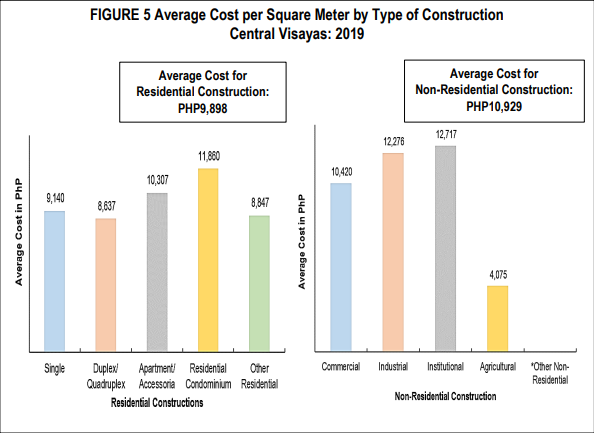
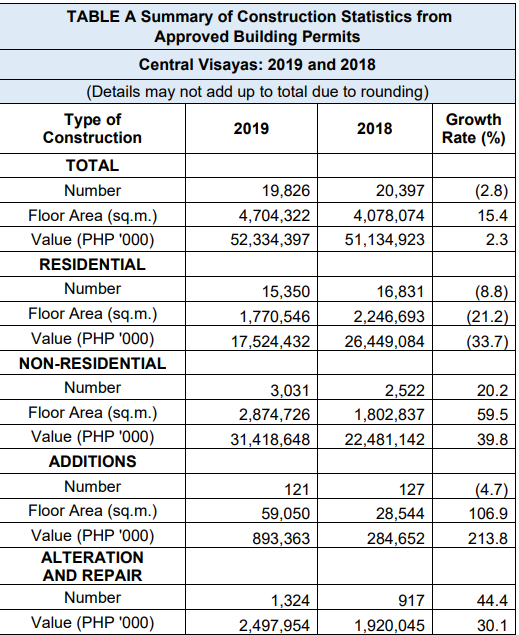
Institutional-type building construction reported the highest average cost of PHP12,717 per square meter with an average floor area of 773.4 square meters per building. Agricultural-type building construction recorded the lowest average cost of PHP4,075 per square meter with an average floor area of 681.6 square meters per building.
Technical Notes
Construction Statistics from Approved Building Permits
Scope and Coverage
Construction statistics presented in this special release are based on approved building permits on new constructions and additions, alterations and repairs of existing residential and non-residential buildings, and other structures which are proposed to be constructed in the different cities/municipalities of the country.
Limitations of Data
Data on building constructions are based from approved applications for construction during the reference period and not on the construction work completed during the reference period.
The completeness of construction data relies on the approved applications filed with the LBOs. Hence, building constructions without approved building permits are excluded in the tabulation of data.
Statistics Generated
Construction statistics generated from approved building permits provide monthly data on building construction at the regional and provincial level. The statistics generated are the following:
Number
floor area
type of construction
value of construction
Aside from the preliminary tables posted in the PSA website, the annual, quarterly and monthly statistical tables at the municipality level by type of construction are available at the Industry Statistics Division (ISD) under the Economic Sector Statistics Service (ESSS) of the PSA.
Definition of Terms (Adopted from the Revised and Updated IRR of the National Building Code)
Building permit is a written authorization granted by the Local Building Official (LBO) to an applicant allowing him to proceed with the construction of a specific project after plans, specifications and other pertinent documents have been found to be in conformity with the National Building Code (PD 1096).
Building refers to any independent, free-standing structure comprised of one or more rooms or other spaces, covered by a roof and enclosed with external walls or dividing walls, which extend from the foundation to the roof.
Construction refers to all on-site work done from site preparation, excavation, foundation, assembly of all the components and installation of utilities, machineries and equipment of buildings/structures.
Residential building is a building for which its major parts or more than half of its gross floor area is built for dwelling purposes. This type of building can be of the single type, duplex, apartment and/or accessoria, and residential condominium.
Single house is a complete structure intended for a single family or household, i.e., bungalow, 2-storey house, nipa hut, etc.
Duplex house is a structure intended for two households, with complete living facilities for each; it is a single structure divided into two dwelling units by a wall extending from the floor to the ceiling.
Apartment is a structure, usually of two storeys, made up of independent living quarters, with independent entrances from internal walls and courts.
Accesoria is a one or two-floor structure divided into several dwelling units, each dwelling unit having its own separate entrance from the outside.
Residential condominium is a structure, usually of several storeys, consisting of multiple dwelling units.
Other residential construction consists of school or company staff houses, living quarters for drivers and maids, and guardhouses.
Non-residential building includes commercial, industrial, agricultural and institutional buildings.
Commercial buildings refer to office buildings and all buildings which are intended for use primarily in wholesale, retail and service trades; i.e., stores, hotels, restaurants, banks, disco houses, etc.
Industrial buildings are buildings used to house the production, assembly and warehousing activities of industrial establishments; i.e., factories, plants, mills, repair shops, machine shops, printing press, storage plant, electric generating plants.
Institutional buildings are buildings which primarily engaged in providing educational instructions and hospital/health care; ports, airports and other government buildings; i.e. school, museums, libraries, sanitaria, churches, hospitals.
Aricultural buildings are buildings used to house livestock, plants and agricultural products such as barn, poultry house, piggeries, stables, greenhouses and grain mill.
Other non-building constructions include cemetery structures, street furniture, waiting sheds, communication towers, etc.
Addition refers to any new construction which increases the height or area of an existing building/structure.
Repair is a remedial work done on any damaged or deteriorated portion/s of a building/structure to restore its original condition.
Renovation is any physical change made on structures to increase their value and quality.
Alteration is a construction in a building/structure involving changes in the materials used, partitioning and location/size of openings, structural parts, existing utilities and equipment but does not increase the overall area thereof.
Conversion is a change in the use or occupancy of structure or any portion thereof, which has different requirements.
Demolitions ref smantling or destruction of a building/structure, in whole or in part.
Street furnitures are street structures consisting of monuments, waiting sheds, benches, plant boxes, lampposts, electric poles and telephone poles.
Floor area of building refers to the sum of the area of each floor of the building measured to the outer surface of the outer walls including the area of lobbies, cellars, elevator shafts and all communal spaces in multi-dwellings. Areas of balconies are excluded.
Total value of construction refers to the sum of the cost of building, electrical, mechanical, plumbing, and others. The value is derived from the approved building permit and represents the estimated value of the building or structure when completed.
Approved by:
(SGD.) ARIEL E. FLORENDO
Regional Director

